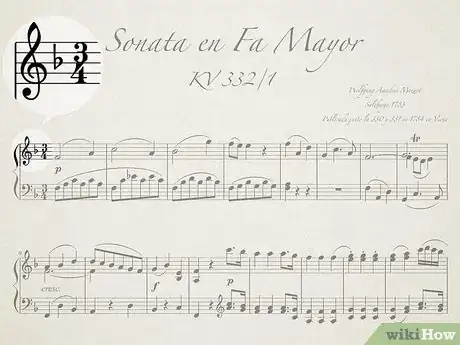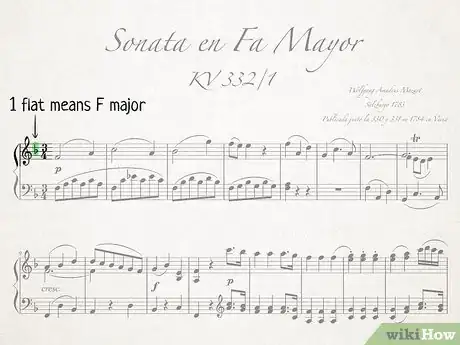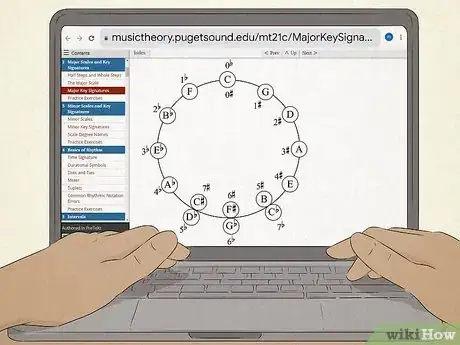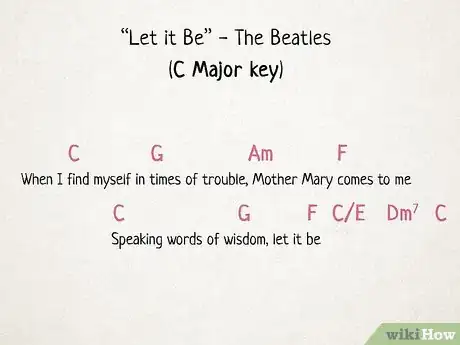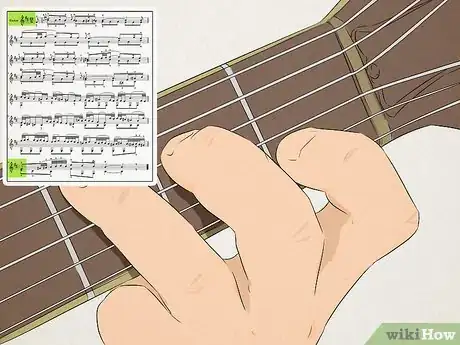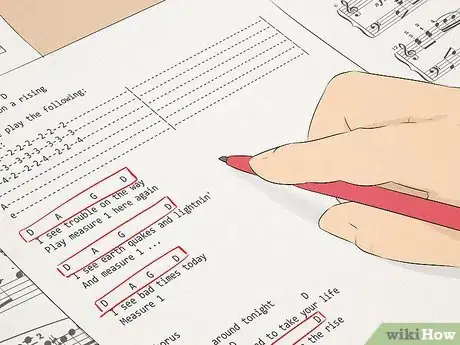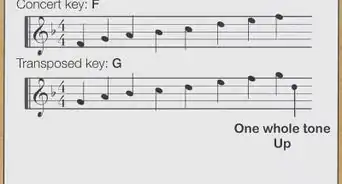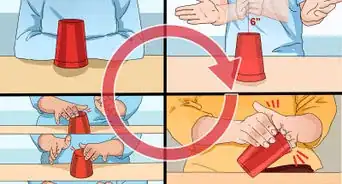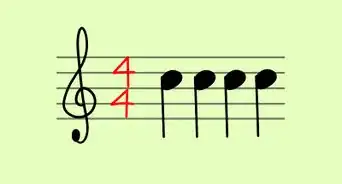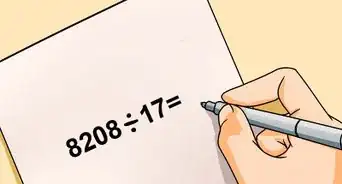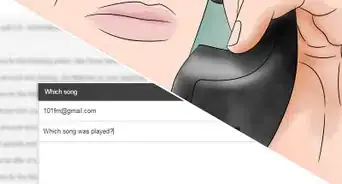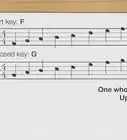This article was co-authored by Amy Chapman, MA and by wikiHow staff writer, Jennifer Mueller, JD. Amy Chapman MA, CCC-SLP is a vocal therapist and singing voice specialist. Amy is a licensed and board certified speech & language pathologist who has dedicated her career to helping professionals improve and optimize their voice. Amy has lectured on voice optimization, speech, vocal health, and voice rehabilitation at universities across California, including UCLA, USC, Chapman University, Cal Poly Pomona, CSUF, CSULA. Amy is trained in Lee Silverman Voice Therapy, Estill, LMRVT, and is a part of the American Speech and Hearing Association.
There are 12 references cited in this article, which can be found at the bottom of the page.
wikiHow marks an article as reader-approved once it receives enough positive feedback. This article received 18 testimonials and 81% of readers who voted found it helpful, earning it our reader-approved status.
This article has been viewed 721,112 times.
All songs are written in a particular key (or keys) that tell you what notes and chords will be used in the song. Finding the key of a song makes it easier for you to play on an instrument. You also need to know the key if you want to experiment with transposing, or changing, the song to a different key to make it easier for you to play or sing the song. While a basic understanding of music theory is helpful to quickly find the key of a song, it isn't essential. Even if you lack training in music theory and can't read music, you can still determine what key a song is in.
Things You Should Know
- Identify what major key a song is in by counting the sharps and flats on the sheet music.
- Determine the relative minor key of a song by comparing the key signature to a circle of fifths chart.
- Study the different chord progressions in a song to identify which key it's in.
- Listen to the song to figure out its tonic note. Play the tonic note on a musical instrument to figure out the song's key.
Steps
Reading the Key Signature
-
1Look for sharp and flat symbols on the top line of the first page of sheet music. If you have the sheet music for the song you want to play, look at the beginning of the top staff lines on the first page.[1] The first thing you'll see is either the treble clef or bass clef symbol. You'll also see 2 numbers, one on top of the other, like a fraction — that's the time signature of the song. Between the clef and the time signature, you'll see a group of sharps or flats that represent the key signature.[2]
- If you see no sharps or flats between the clef and the time signature, the song is in the key of C.
-
2Count the number of sharps or flats to determine the major key. Key signatures have either all sharps or all flats. You can use the number of sharps or flats in the key signature to determine the major key represented by that key signature.[3]
- 1 sharp: G; 1 flat: F
- 2 sharps: D; 2 flats: B flat
- 3 sharps: A; 3 flats: E flat
- 4 sharps: E; 4 flats: A flat
- 5 sharps: B; 5 flats: D flat
- 6 sharps: F sharp; 6 flats: G flat
Advertisement -
3Find the major key by identifying the last sharp or second-to-last flat. If you can't remember the number of sharps or flats that correspond to each major key, you can also look at the sharps or flats in the key signature. For any key signature with flats, the second-to-last flat (reading from left to right) is the major key it represents. If the key signature has sharps, the note a half-step up from the last sharp is the name of the key.[4]
- For example, the key signature for G has 1 sharp — F sharp. One half-step up from F sharp is G.
- With flats, read the flats from left to right and look at the second to last one. For example, the key signature for B flat has 2 flats, so the first flat, B flat, is also the second to last.
-
4Refer to the circle of fifths to find the relative minor key. Every key signature represents both a major and a minor key (referred to as the "relative" minor). The circle of fifths shows how the 12 tones of the chromatic scale relate to one another. The capital letters on the outside of the circle represent the major keys and the lower case letters on the inside of the circle represent the minor keys. The minor key at the same point on the circle as the major key is the relative minor of that major key.[5]
- For example, suppose you have a key signature with 1 sharp, which you know is G Major. If you look on the circle of fifths, you'll see a lower-case "e" in the same position on the circle as G Major. That tells you that E minor is the relative minor of G Major.
- Each key is one-fifth apart if you go around the circle clockwise, which is why it's called the "circle of fifths." If you go counter-clockwise, the keys are only a fourth apart, so sometimes you'll also hear it referred to as the "circle of fourths," but both of these terms refer to the same thing.
-
5Use the order of notes in the song to figure out if it's major or minor. You can often determine if a song is in a major or minor key just by listening to it. However, you can also tell simply by looking at the sheet music (provided you know how to read music). Look at the notes used in the song and try to identify the major or minor scale notes.[6]
- The major and minor scales use the same notes, but they start in a different place. If you can see pieces of these scales in the song, you'll be able to identify the scale.
- You can also look at the first and last notes of the song. Typically, one or both of them will be the same note as the name of the key. So, for example, if the song ends on G, you might determine that the song is in G major and not E minor.
Analyzing Chord Progressions
-
1Find the first and last chords of the song. Although this isn't always the case, usually the first and last chord of a song will tell you what key the song is in.[7] If you know the first chord of the song, especially if it's one that repeats throughout the song, it's likely also the key the song is in.[8]
- For example, "Fireflies," by Owl City, is in D sharp/E flat Major, but it starts and ends with a G chord. And while originally an electronic song, it's a simple and pretty song to play on guitar.[9]
- If the last chord of the song makes the song feel unsettled, it probably doesn't identify the key the song is in. However, if it brings resolution to the song, the song is probably in that key.
-
2Identify other chords that are in the same key. There are 7 chords in each key. Songwriters put these chords together in different chord progressions to create a song, but any of the 7 chords in the same key naturally sound good together. Start with the first chord in the song, then look at the next 2 or 3 chords that follow. This can help you confirm the key the song is in.[10]
- For example, the song "Bad Moon Rising," by Creedence Clearwater Revival, has only 3 chords: D, A, and G.[11] The first chord is a D, and the D-A-G pattern continues through the verses, with the choruses switching up to G-D-D-A-G-D. All 3 of these chords are found in the key of D Major, and the song starts with D, so if you guessed the song is in D Major based on that information, you'd be correct.
- Most keys have 1 or 2 chords in common, but never more than 2. If you identify 3 or 4 chords, you can identify the key.
-
3Look for chords in the same key throughout the song. Use a chord chart to find all 7 chords in the key, then look for those chords in the song. While there may be other chords, particularly if the song has a bridge, you'll likely see the same theme repeating throughout the song.[12]
- If you're using a tab, you might also see Roman numerals at the top of the page that tell you the chord progression. For example, I-IV-V is a common chord progression. If the song was in D Major, the chords used would be D, G, and A — the chords already identified in "Bad Moon Rising."
- Many simple pop and rock songs are 3- or 4-chord songs, which makes it relatively easy to determine what key the song is in if you have a basic understanding of the chords in each key.
Finding the Key by Ear
-
1Listen to the song without any distractions. Play a recording of the song in headphones and pay attention to the music. You may have to listen to it a few times before you can really focus on the music, especially if you aren't familiar with the song.[13]
- As you listen, try to pinpoint the note that seems to resolve each musical phrase, the note that feels like home. This will likely be a note the music returns to many times throughout the song. This note is referred to as the "tonic note" or the "tonal center" of the song and tells you what key the song is in.
-
2Hum the tonic note while listening to the song again. Play the recording of the song one more time, humming the tonic note you found as you listen. If it fits right into the background of the song, that note is the key the song is in.[14]
- If the note doesn't blend in or seems to clash with the song, you might not have chosen the right note. If you don't have perfect pitch, though, it might also be the case that your humming was slightly off-key.
- Many pop and rock songs change key. To identify the main key the song is written in, repeat the music behind verses, as opposed to the music accompanying the bridge or even the chorus.
-
3Play the tonic note on your instrument to confirm the key. Make sure your instrument is in tune, then find the note you've decided is the tonic note, or the key of the song. Start your recording of the song, then play that note on your own instrument in the background of the song. This can help you confirm (better than humming) that you've correctly identified the key for the song.[15]
- If you don't have perfect pitch, you might have to noodle around a little on your instrument before you find the note that matches the one you identified. You might also have to play the recording again. Just keep at it! This kind of experience helps train your ear so notes will be easier to find by ear in the future.
- If you're playing a guitar, you can play either the chord or the single note. If the chord sounds like it fits along with the song, you've also found the key.
-
4Use the mood of the music to determine if it's major or minor. If the music is bright and cheery sounding, it's likely in a major key. On the other hand, darker, more ominous-sounding songs are typically written in a minor key. Assuming you've already played the song several times, you probably already have a good idea whether it's in a major or minor key.[16]
- Go back to your tonic note and look at how the other notes or chords in the song relate to that tonic note.
- This applies to the way the music of a song sounds, not the lyrics. Songwriters often juxtapose melancholy or serious lyrics with music in a bright and poppy major key (think "Semi-Charmed Life," by Third Eye Blind, or "Hey Ya!" by Outkast, both in G Major).[17]
Expert Q&A
Did you know you can get premium answers for this article?
Unlock premium answers by supporting wikiHow
-
QuestionHow can I tell what key a song is in on sheet music?
 Amy Chapman, MAAmy Chapman MA, CCC-SLP is a vocal therapist and singing voice specialist. Amy is a licensed and board certified speech & language pathologist who has dedicated her career to helping professionals improve and optimize their voice. Amy has lectured on voice optimization, speech, vocal health, and voice rehabilitation at universities across California, including UCLA, USC, Chapman University, Cal Poly Pomona, CSUF, CSULA. Amy is trained in Lee Silverman Voice Therapy, Estill, LMRVT, and is a part of the American Speech and Hearing Association.
Amy Chapman, MAAmy Chapman MA, CCC-SLP is a vocal therapist and singing voice specialist. Amy is a licensed and board certified speech & language pathologist who has dedicated her career to helping professionals improve and optimize their voice. Amy has lectured on voice optimization, speech, vocal health, and voice rehabilitation at universities across California, including UCLA, USC, Chapman University, Cal Poly Pomona, CSUF, CSULA. Amy is trained in Lee Silverman Voice Therapy, Estill, LMRVT, and is a part of the American Speech and Hearing Association.
Singing Coach
-
QuestionHow can I determine what key a song is by ear?
 Amy Chapman, MAAmy Chapman MA, CCC-SLP is a vocal therapist and singing voice specialist. Amy is a licensed and board certified speech & language pathologist who has dedicated her career to helping professionals improve and optimize their voice. Amy has lectured on voice optimization, speech, vocal health, and voice rehabilitation at universities across California, including UCLA, USC, Chapman University, Cal Poly Pomona, CSUF, CSULA. Amy is trained in Lee Silverman Voice Therapy, Estill, LMRVT, and is a part of the American Speech and Hearing Association.
Amy Chapman, MAAmy Chapman MA, CCC-SLP is a vocal therapist and singing voice specialist. Amy is a licensed and board certified speech & language pathologist who has dedicated her career to helping professionals improve and optimize their voice. Amy has lectured on voice optimization, speech, vocal health, and voice rehabilitation at universities across California, including UCLA, USC, Chapman University, Cal Poly Pomona, CSUF, CSULA. Amy is trained in Lee Silverman Voice Therapy, Estill, LMRVT, and is a part of the American Speech and Hearing Association.
Singing Coach
-
QuestionWhat if there is nothing in the key signature?
 wikiHow Staff EditorThis answer was written by one of our trained team of researchers who validated it for accuracy and comprehensiveness.
wikiHow Staff EditorThis answer was written by one of our trained team of researchers who validated it for accuracy and comprehensiveness.
Staff Answer wikiHow Staff EditorStaff Answer
wikiHow Staff EditorStaff Answer
Warnings
- Contemporary rock and pop songs often change keys (typically singing back and forth between the major key and the relative minor key). Figuring out the main key of the song doesn't guarantee that the whole song is in that key.[19]⧼thumbs_response⧽
References
- ↑ Amy Chapman, MA. Singing Coach. Expert Interview. 18 October 2019.
- ↑ http://musictheoryfundamentals.com/MusicTheory/keySignatures.php
- ↑ http://musictheoryfundamentals.com/MusicTheory/keySignatures.php
- ↑ http://musictheory.pugetsound.edu/mt21c/MajorKeySignatures.html
- ↑ https://www.musicnotes.com/now/tips/circle-of-fifths-guide/
- ↑ https://www.musicnotes.com/now/tips/4-ways-to-identify-major-and-minor-keys/
- ↑ Amy Chapman, MA. Singing Coach. Expert Interview. 18 October 2019.
- ↑ https://www.themusicalear.com/how-to-identify-key-signatures/
- ↑ https://www.uberchord.com/blog/fireflies-by-owl-city-lyrics-with-guitar-chords/
- ↑ https://countryguitaronline.com/chords-in-each-major-key/
- ↑ https://www.guitaretab.com/c/creedence-clearwater-revival/25442.html
- ↑ https://www.musicnotes.com/now/tips/4-ways-to-identify-major-and-minor-keys/
- ↑ https://www.guitartricks.com/blog/What-Key-is-this-Song-In-How-to-find-the-Key-of-a-Song
- ↑ https://www.guitartricks.com/blog/What-Key-is-this-Song-In-How-to-find-the-Key-of-a-Song
- ↑ https://www.musicnotes.com/now/tips/4-ways-to-identify-major-and-minor-keys/
- ↑ https://www.guitartricks.com/blog/What-Key-is-this-Song-In-How-to-find-the-Key-of-a-Song
- ↑ https://popcrush.com/songs-sound-happy-dark-lyrics/
- ↑ http://www.fretjam.com/key-by-ear.html
- ↑ https://www.themusicalear.com/how-to-identify-key-signatures/
About This Article
To determine what key a song is in when you have the sheet music, look at the key signature, which is the set of markings between the clef and the time signature. If there are flats, the key is the name of the second-to-last flat when read from left to right. For key signatures using sharps, the key is the note that’s ½ step up from the last sharp marking. Alternatively, if you’re using a chord chart to play the guitar, the key is most likely the same as the starting and ending chords. For example, if a piece of music ends with a D chord, the song is probably in the key of D. For tips on how to figure out the key of a song by ear, keep reading!
